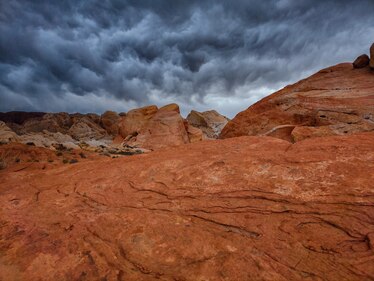Mars on Earth

Sandstone Arches: Valley of Fire State Park, Nevada
It’s the rich, red color and organic, alien feel of the shapes carved into the sandstone that make this image seem so much like Mars. Photographs of the Vera Rubin Ridge on Mars have shown it to have finely layered rock formations like these. “This small scene holds a unique quality,” comments Keith. “The light places emphasis on the most notable aspect of the frame.”
Lighting up the Lava Tube: Mojave National Reserve, California
A warm ray of light illuminates the interior of the Lava Tube at Mojave National Reserve. “This image has a mood that I really love,” says Keith. “It's mysterious, draws you into the light, and prompts the desire to explore.” It is possible that the lava tubes of Mars—100 times wider than those on Earth—could be one of the best places to look for life.
Stormy Skies: Valley of Fire State Park, Nevada
Dark clouds dominate the sky over the rusty-red landscape of Nevada’s Valley of Fire. With little rainfall, scenes like this are extremely rare in the Mojave Desert. “The clouds create a foreboding above that complements the harsh landscape below,” says Keith. The desert’s distinctive rusty color comes from high levels of iron oxide, the same compound that makes Mars red.
Casting Shadows in a Canyon: Death Valley, California
This photo captures the last kiss of sunlight over a canyon in Death Valley. “I love the quality of light hitting the lower portion of the frame,” says Keith. “It emphasises the texture of the erosion, and leads you further into the image.” On Mars, rushing water carved out the Valles Marineris canyon, but on a much larger scale—surface scars are six miles deep for 2,500 miles.
Stripes in a Slot Canyon: Death Valley, California
In this small slot canyon, water erosion has created a series of compelling wavy stripes. “I love the light in this image,” Keith says, “and the way the leading lines and curves are an invitation to walk through this narrow canyon.” Its distinctive layers of rock are similar to those photographed by NASA’s Mars rover Curiosity on the lower slopes of Mount Sharp.
Darkening Storm: Death Valley, California
Storm clouds and pockets of light dance over Zabriskie Point in Death Valley. “I love the mood of this image,” reflects Keith. “The textured skies and foreground complement one another beautifully.” With a striking absence of life across the whole panorama, and the hint of pink on the distant mountains, we are reminded of the desolate beauty of Mars.
Pink Salt Crystals: Death Valley, California
Pink halite―salt―crystals growing at Searles Lake, California. “I like the depth of this image,” Keith says, “with the cubed crystals seated on the vibrant bacteria-rich salt.” The vivid pink color certainly makes us think of Mars, and so should salt. The Red Planet is known to have numerous deposits of chloride minerals, and scientists believe that pools of salty water may exist underground.
Starlight and Stone: Trona Pinnacles, California
The clear night sky forms a stunning backdrop to this lone feature at Trona Pinnacles. “I like the crisp detail of the stars against which the illuminated spire of rock provides an otherworldly mood,” says Keith. There is a palpable sense of isolation. When the first humans travel to Mars, they will be nearly 40 million miles from home: it is easy to imagine them feeling a similar sense of solitude.
Last Light: Valley of Fire, Nevada
A sandstone upheaval catches the last hint of sunlight against the rich, red backdrop of a Mars-like landscape. “I love the depth and scale,” says Keith. “Anchored by the large feature in the foreground, as you explore the rest of the image you begin to feel the scale of where you are.” This shot is evocative of the sweeping views of Mount Sharp taken by NASA’s Mars rover Curiosity.
Alien Landscape on Earth: Trona Pinnacles, California
These towering pinnacles of eerily eroded limestone have been featured in many movies. “This scene, very three-dimensional in its mood, reminded me of an ancient forgotten place—perhaps Easter Island,” considers Keith. “I love how the warm light of twilight highlights select portions of the landscape.” The pockmarked rock in the foreground is similar to the volcanic rocks that NASA’s Mars rover Spirit found scattered across the surface of Mars.
Sunset: Valley of Fire, Nevada
The setting sun hits a sandstone upheaval in this aerial shot over Valley of Fire. “I like the exposure here,” says Keith. “The scale, and the sun flare coming in from the right, create a warm atmosphere.” The sharp, shadowy ridges of this rocky outcrop are reminiscent of aerial views taken of the central mountains of the Hale Crater on Mars.